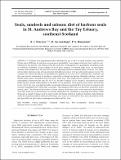Files in this item
Seals, sandeels and salmon : diet of harbour seals in St. Andrews Bay and the Tay Estuary, southeast Scotland
Item metadata
| dc.contributor.author | Sharples, Ruth Jemma | |
| dc.contributor.author | Arrizabalaga, B | |
| dc.contributor.author | Hammond, Philip Steven | |
| dc.date.accessioned | 2013-09-17T23:20:37Z | |
| dc.date.available | 2013-09-17T23:20:37Z | |
| dc.date.issued | 2009 | |
| dc.identifier | 450712 | |
| dc.identifier | 767fcec2-07cd-4a85-ad85-23bb4a7d380d | |
| dc.identifier | 70349550019 | |
| dc.identifier.citation | Sharples , R J , Arrizabalaga , B & Hammond , P S 2009 , ' Seals, sandeels and salmon : diet of harbour seals in St. Andrews Bay and the Tay Estuary, southeast Scotland ' , Marine Ecology Progress Series , vol. 390 , pp. 265-276 . https://doi.org/10.3354/meps08232 | en |
| dc.identifier.issn | 0171-8630 | |
| dc.identifier.other | standrews_research_output: 30563 | |
| dc.identifier.other | ORCID: /0000-0002-2381-8302/work/47531595 | |
| dc.identifier.uri | https://hdl.handle.net/10023/4057 | |
| dc.description | R.J.S. was supported by a NERC studentship (NER/S/A/2000/03635) | en |
| dc.description.abstract | Harbour seal populations have declined by up to 40% around northern and eastern Britain since 2000 due to unknown causes; prey availability is one important factor that could be contributing to the decline. We estimate the diet and prey consumption of a population of harbour seals in southeast Scotland, using analysis of hard prey remains recovered from scats, to investigate change in the importance of sandeels over 6 yr spanning the local sandeel fishery closure. The study site includes Special Areas of Conservation for harbour seals as well as vulnerable salmon stocks. We estimate the extent of harbour seal predation on salmon in the area. In St. Andrews Bay, harbour seal diet was heavily dominated by sandeels, especially in winter and spring. Gadoids (whiting, cod) and flatfish (dab, plaice, flounder) were the other main prey. The proportion of sandeels in the diet was remarkably consistent over time (71 to 77%), but the average size of sandeels consumed increased following the closure of the fishery. In the Firth of Tay, sandeels were prevalent in winter, but the diet in the rest of the year was dominated by salmonids: salmon comprised 64% of the diet in summer and sea trout comprised 40% of the diet in autumn. Thus marked differences in diet were evident at a fine spatial scale. The effects of the sandeel fishery closure on harbour seals were equivocal, but harbour seals that haul out in SE Scotland are clearly dependent on sandeels; re-opening the fishery could thus have a negative impact and be inadvisable. We found evidence that local harbour seal predation could be impacting salmon stocks but the high uncertainty in estimates of seal diet and salmon stock size preclude the provision of management advice at this time. | |
| dc.format.extent | 233354 | |
| dc.language.iso | eng | |
| dc.relation.ispartof | Marine Ecology Progress Series | en |
| dc.subject | Faecal sampling | en |
| dc.subject | Fisheries | en |
| dc.subject | North Sea | en |
| dc.subject | Prey availability | en |
| dc.subject | Phoca vitulina | en |
| dc.subject | Special Area of Conservation | en |
| dc.subject | QL Zoology | en |
| dc.subject | SDG 14 - Life Below Water | en |
| dc.subject.lcc | QL | en |
| dc.title | Seals, sandeels and salmon : diet of harbour seals in St. Andrews Bay and the Tay Estuary, southeast Scotland | en |
| dc.type | Journal article | en |
| dc.contributor.institution | University of St Andrews. School of Biology | en |
| dc.contributor.institution | University of St Andrews. Scottish Oceans Institute | en |
| dc.contributor.institution | University of St Andrews. Marine Alliance for Science & Technology Scotland | en |
| dc.identifier.doi | 10.3354/meps08232 | |
| dc.description.status | Peer reviewed | en |
| dc.date.embargoedUntil | 2013-09-18 | |
| dc.identifier.url | http://www.scopus.com/inward/record.url?scp=70349550019&partnerID=8YFLogxK | en |
This item appears in the following Collection(s)
Items in the St Andrews Research Repository are protected by copyright, with all rights reserved, unless otherwise indicated.

